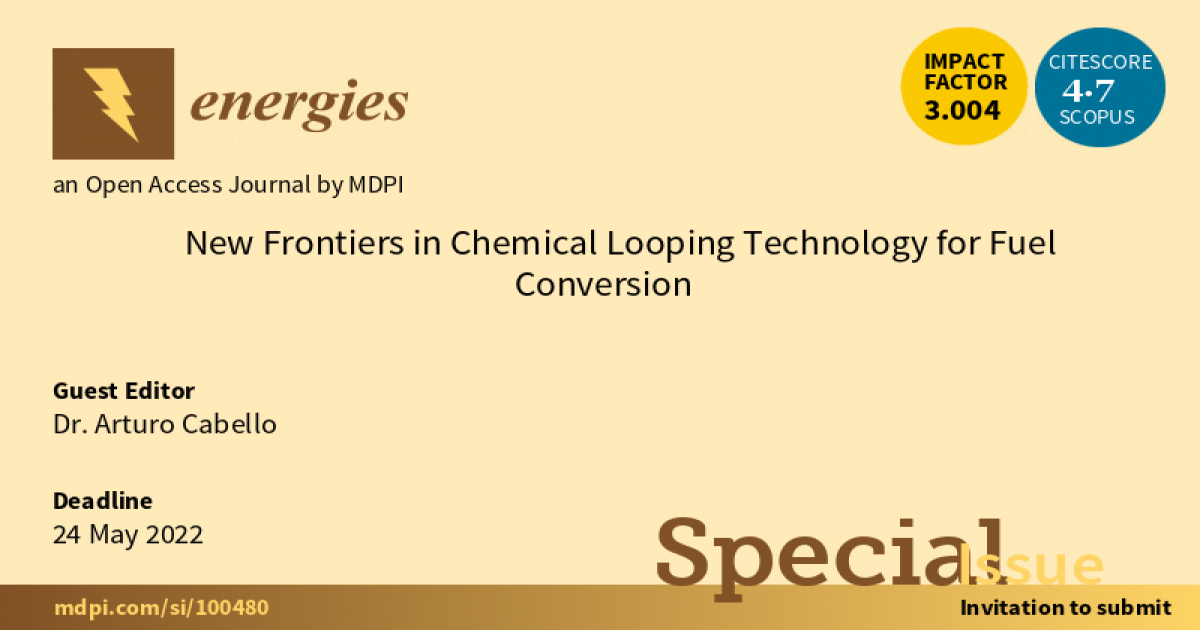New Frontiers in Chemical Looping Technology for Fuel Conversion
A special issue of Energies (ISSN 1996-1073). This special issue belongs to the section "I1: Fuel".
Deadline for manuscript submissions: closed (24 May 2022) | Viewed by 5011

Special Issue Editor
Interests: development of oxygen carriers for chemical looping processes; chemical looping technologies (CLC and CLR) at pressurized conditions; development of techno-economic analyses focused on chemical looping technologies; production of syngas and hydrogen through chemical looping processes using biofuels; new applications of chemical looping: high-temperature thermochemical energy storage, deoxygenation, epoxidation, oxidative dehydrogenation, oxidative coupling of CH4, selective oxidation, fluid catalytic cracking (FCC), etc.
Special Issue Information
Dear Colleagues,
Chemical looping is one of the most promising technologies for efficient fuel conversion with inherent CO2 capture. Most of the research carried out to date in chemical looping has focused on fossil fuel combustion processes for the production of electricity and heat. However, chemical looping technologies exhibit high flexibility and versatility that allow them to use a wide range of fuels, both fossil and renewable, and to be applied to a large number of energy and chemical processes.
One of the main challenges in chemical looping technologies is their application to industrial-scale processes. In this regard, a great effort still needs to be made addressing technical gaps in chemical looping to be on track to validate the processes for the next scale of large pilot demonstrations.
For this Special Issue of Energies (IF: 3.004) entitled “New Frontiers in Chemical Looping Technology for Fuel Conversion”, we would like to encourage original contributions regarding the scale-up of chemical looping processes and new applications of chemical looping. Potential topics include, but are not limited to: the development of oxygen carriers; the design and operational experiences of chemical looping reactors and plants; the development of chemical looping processes under pressurized conditions; chemical looping processes for hydrogen and syngas production; the chemical looping conversion of biofuels; chemical looping modelling and process simulation; techno-economic analysis of chemical looping technologies; chemical looping for high-temperature thermochemical energy storage; chemical looping deoxygenation; chemical looping epoxidation; methane-to-methanol via chemical looping; chemical looping partial oxidation; application of chemical looping in mitigating ventilation air methane (VAM) emissions; chemical looping oxidative dehydrogenation; chemical looping for the oxidative coupling of methane; chemical looping selective oxidation; and the application of chemical looping combustion to fluid catalytic cracking processes (CLC-FCC).
Dr. Arturo Cabello
Guest Editor
Manuscript Submission Information
Manuscripts should be submitted online at www.mdpi.com by registering and logging in to this website. Once you are registered, click here to go to the submission form. Manuscripts can be submitted until the deadline. All submissions that pass pre-check are peer-reviewed. Accepted papers will be published continuously in the journal (as soon as accepted) and will be listed together on the special issue website. Research articles, review articles as well as short communications are invited. For planned papers, a title and short abstract (about 100 words) can be sent to the Editorial Office for announcement on this website.
Submitted manuscripts should not have been published previously, nor be under consideration for publication elsewhere (except conference proceedings papers). All manuscripts are thoroughly refereed through a single-blind peer-review process. A guide for authors and other relevant information for submission of manuscripts is available on the Instructions for Authors page. Energies is an international peer-reviewed open access semimonthly journal published by MDPI.
Please visit the Instructions for Authors page before submitting a manuscript. The Article Processing Charge (APC) for publication in this open access journal is 2600 CHF (Swiss Francs). Submitted papers should be well formatted and use good English. Authors may use MDPI's English editing service prior to publication or during author revisions.
Keywords
- development of oxygen carriers
- chemical looping combustion
- chemical looping reforming
- H2 production
- syngas production
- chemical looping at pressurized conditions
- CO2 capture
- biofuels
- negative CO2 emissions
- chemical looping modelling and process simulation
- techno-economic analyses
- chemical looping new applications





